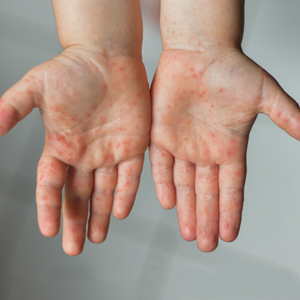
Area healthcare providers have been seeing an increased number of cases of hand, foot and mouth disease in recent weeks.
The disease, not the same as foot-and-mouth disease affecting cows, sheep, and pigs, is a mild, contagious viral infection common in young children and is characterized by sores in the mouth and a rash on the hands and feet.
WHAT CAUSES HAND, FOOT, AND MOUTH DISEASE?
"The virus, most commonly caused by a coxsackievirus, can occur at any time of year but is most common in the summer and fall and often the disease breaks out within a community," said Dr. Evan Altman, medical director for the Baystate Urgent Care and Baystate Convenient Care located at Baystate Wing Hospital in Palmer.
Hand, foot, and Mouth disease is not transmitted to or from pets or other animals. According to the Centers for Disease Control (CDC), the disease is spread from person to person by direct contact with the virus through nose and throat secretions such as saliva, sputum, or nasal mucus, fluid in blisters, and stool of infected persons. The viruses may be spread when infected persons touch objects and surfaces that are then touched by others or by breathing in respiratory droplets from an infected person who coughs or sneezes.
WHAT ARE THE SYMPTOMS OF HAND, FOOT, AND MOUTH?
Infected persons are most contagious during the first week of the illness and illness can last 7-10 days. The disease-causing viruses can remain in the body for weeks after a person's symptoms have gone away. This means that infected people are contagious and can still pass the infection to others even though they may appear well. Some people who are infected and shedding the virus, including most adults, may have no symptoms.
"Once exposed to the virus, it usually takes three to six days for a person to get symptoms," said Dr. Altman. "Hand, foot, and mouth disease usually starts with a fever, poor appetite, a vague feeling of being unwell and a sore throat. A day or two after the fever starts; painful sores usually develop in the mouth.”
"They begin as small red spots that blister and that often become ulcers,” said Dr. Altman. “A skin rash may also develop over one to two days. The rash has flat or raised red spots, sometimes with blisters. The rash is usually on the palms of the hands and soles of the feet; it may also appear on the knees, elbows, buttocks or genital area. The sores and blisters usually go away in a week or so."
HOW IS HAND, FOOT, AND MOUTH DISEASE TREATED?
"It's a virus that just needs to run its course," said Dr. Altman. "If your child has a relatively mild case of this illness, symptoms can be treated at home. While is no specific medical treatment for hand, foot, and mouth disease, you can take steps to relieve symptoms and prevent dehydration while you or your child is sick.”
HOME REMEDIES
Acidic, salty, or spicy foods and drinks may irritate blisters in the mouth or throat. Certain soothing foods can help:
- Popsicles
- Ice cream
- Ice water
- Soft foods
WHEN TO SEE A HEALTHCARE PROVIDER
- Your child is not drinking enough to stay hydrated
- Symptoms do not improve after 10 days
- Your child has a weakened immune system
- Fever lasting beyond 72 hours
- Symptoms are severe
- Your child is very young, especially younger than 6 months
HOW CAN YOU PREVENT HAND, FOOT, AND MOUTH DISEASE?
You can reduce your risk of infection from hand, foot, and mouth disease by washing your hands often and thoroughly, washing and disinfecting toys and other objects that might have germs on them, and trying to avoid infected children.
"Hand, foot and mouth disease is common in children under age 5 but can also occur in adults. Health complications are not common, if you're not sure that you are dealing with hand foot and mouth disease, your pediatrician or healthcare provider can confirm a diagnosis by taking a look," said Dr. Altman.
ABOUT CONVENIENT CARE AT BAYSTATE WING HOSPITAL
Dr. Evan Altman, medical director of Baystate Convenient Care in Palmer, and the care team offer urgent same-day, walk-in care for common medical conditions including sports injuries and sprains, seasonal allergies, skin rashes and urinary tract infections.
Convenient Care is located on the first floor of Baystate Wing Hospital within the Baystate Health & Wellness Center – Palmer, next to Baystate Primary Care. Convenient Care is open Monday through Friday, 9 am to 7 pm and Saturday and Sunday 8 am to 4 pm For more information call 413-370-7000.